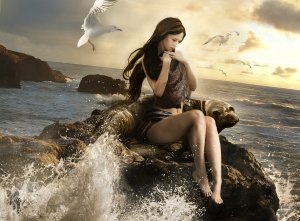A selkie coming ashore changing from her seal skin. Source: public domain.
Selkies, also called Selchies and Silkies, are supernatural and shape-shifting entities in the folklores of Scotland, Ireland and the Faroe Islands. They are also referred to as roane as well as occurring in the traditions of Iceland. In Wales the local selkie are believed to be human beings who have returned to the sea as merfolk or sea sprites. In their original form these fairies or seal shape-shifting humans occur in the tales and myths of many cultures worldwide. In some legends they are regarded as similar to Swan Maidens.
They live primarily in the seas surrounding the Shetland and Orkney Islands and the surrounding Norse ‘seaway’.. In the ocean they are large travelling seals but discard temporarily their seal-skin when venturing ashore. Ashore they are believed to occasionally consort with humans. Etymologically the name is derived from an earlier Scottish word selich which itself comes from the Old English seolh for seal. In both Scottish and Irish folklore and tales “…we find supernatural qualities attributed to seals. Descent from seals is claimed by numerous families.” (Puhvel, 1962). When coming to land the female sheds her skin and changes into a human. Eventually the female selkie, even if living with a man and bearing him children, will retrieve her skin and return to the sea.
A selkie in human form and a seal sitting on a rock. (Source: public domain.
Despite sharing some of their characteristics selkies are not, strictly speaking, mermaids. In the Orkney’s selkies are sometimes asserted to be the souls of those drowned at sea. Orcadian folktales have claimed that the selkie were once humans fated to live out their days in the sea for some wrong-doing. Claims that they were some type of fairy or fallen angel were once common in local belief. Their origin does suggest a Celtic history though it has been suggested that they part of the mythology surrounding the Scandinavian finfolk. Despite the origin of the folklore of the selkies, despite having no precise explanation, it is possible that there is an association with a Scandinavian source as well as their Celtic one.
References and Sources Consulted
Craigie, W. A. (1898). Some Highland Folklore. Folklore. 9 (4).
Harris, J. M. (2009). Perilous Shores. Mythlore. 78.
MacKenzie, W. A. (1935). Scottish Folk-lore and Folk-life. Blackie, Edinburgh.
Puhvel, M. (1963). The Seal in the Folklore of Northern Europe. Folklore. 74 (1).
Spence, L. (1948). The minor traditions of British mythology. Ayer Publishing.
Westwood, J. & Kingshill, S. (2011). The Encyclopaedia of Celtic Mythology and Folklore. Infobase Publishing.



Is the artwork at the very top created by Eric Edwards? The one where she is standing/coming out of the water? Because there is another artist that is using it on his website and selling them as his own. Unless it is his? But it is new on his instagram site.
The artwork at the top of the page is by James Browne. If you look closely at the bottom left of the image, you can see his signature. He should really be credited below it instead of claiming it is a public domain image.
I want to mention the first work is my James Browne. On the original image theres the Adress http://www.JamesBrowne.net at the very bottom. Here it has been removed.